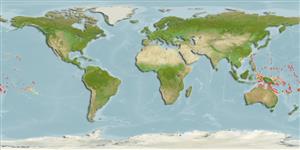>
Blenniiformes (Blennies) >
Blenniidae (Combtooth blennies) > Salariinae
Etymology: Cirripectes: Latin, cirrus = curl fringe + Greek, pektos, -e, -on = made of several parts solidly united (Ref. 45335); fuscoguttatus: Specific epithet 'fuscus' meaning dusky or dark and 'guttatus' meaning spotted, referring to the dark brown spots on head and body..
More on authors: Strasburg & Schultz.
Environment: milieu / climate zone / depth range / distribution range
بوم شناسي
دريايي وابسته به آب سنگ; تغييرات عمق 0 - 8 m (Ref. 529). Tropical; 27°N - 25°S
Pacific Ocean: southern Taiwan to Tuamoto Islands, south to Tonga; throughout Micronesia.
Length at first maturity / Size / Weight / سن
Maturity: Lm ?, range 6 - ? cm
Max length : 10.6 cm SL جنس نر / بدون خواص جنسي; (Ref. 529)
خارهاي باله پشتي (کل) : 12; شعاع نرم باله پشتي (کل) : 13 - 15; خارهاي باله مخرجي: 2; شعاع نرم باله مخرجي: 14 - 16; مهره ها: 30. Diagnosis: Dorsal fin XII, 14, membrane attached to caudal fin, with deep notch above last spine, first spine almost same or slightly higher than second; anal fin II, 15; pectoral rays 15; pelvic fin I, 4; caudal fin procurrent rays 11-14. Vertebrae 10 + 20. LL, without scales and scalelike flaps; LL tubes 0-3 (sometimes up to 5), canal ends below 13th dorsal spine to caudal-fin base. Upper lip crenulae 40-55. Gill rakers 22-32. Cephalic sensory pore system complex. Cirri: supraorbital 18-42 (usually 20-37); nasal 7-32 (usually 11-27); nuchal 47-66 (usually 50-60), in 4 groups with 2 or more sometimes connected basally by a frenum, dorsalmost groups usually meet or overlap at midpoint on nape, ventralmost group on each side borne on broadly expanded flap. Head with dark brown spots on pale background; orangish red iris; yellow pelvic fins; pectoral fins spotted on proximal half. (Ref. 529).
Facultative air-breathing in the genus (Ref. 126274); Typically found in the surge zone of coral reefs from 0-8 m deep (Ref. 529). Oviparous. Eggs are demersal and adhesive (Ref. 205), and are attached to the substrate via a filamentous, adhesive pad or pedestal (Ref. 94114). Larvae are planktonic, often found in shallow, coastal waters (Ref. 94114).
Oviparous, distinct pairing (Ref. 205). Urogenital orifice of male genital papilla located basally between 2 widely separated slender filaments on a fleshy swelling behind anus; testes bulbous with length equal to its width (Ref. 529).
Williams, J.T., 1988. Revision and phylogenetic relationships of the blenniid fish genus Cirripectes. Indo-Pac. Fish. (17):78 p. (Ref. 529)
وضعيت در فهرست قرمز IUCN (Ref. 130435)
خطر برای انسان ها
Harmless
استفاده انسانی
ماهي گيري – شيلات: از بی علاقه گی
ابزارها
گزارش های ويژه
بارگيری XML
منابع اينترنتي
Estimates based on models
Preferred temperature (Ref.
123201): 25.2 - 29.4, mean 28.3 °C (based on 1194 cells).
Phylogenetic diversity index (Ref.
82804): PD
50 = 0.5000 [Uniqueness, from 0.5 = low to 2.0 = high].
Bayesian length-weight: a=0.01072 (0.00480 - 0.02393), b=3.01 (2.82 - 3.20), in cm total length, based on LWR estimates for this (Sub)family-body shape (Ref.
93245).
Trophic level (Ref.
69278): 2.0 ±0.00 se; based on food items.
جهندگی (Ref.
120179): زياد, كمينه زمان لازم براي دو برابر شدن جمعيت ، كمتر از 15 ماه (Preliminary K or Fecundity.).
Fishing Vulnerability (Ref.
59153): Low vulnerability (10 of 100).
Nutrients (Ref.
124155): Calcium = 132 [69, 230] mg/100g; Iron = 0.871 [0.504, 1.445] mg/100g; Protein = 18.4 [17.2, 19.5] %; Omega3 = 0.12 [0.07, 0.20] g/100g; Selenium = 18.2 [9.9, 36.2] μg/100g; VitaminA = 127 [35, 455] μg/100g; Zinc = 2.55 [1.70, 3.67] mg/100g (wet weight);
